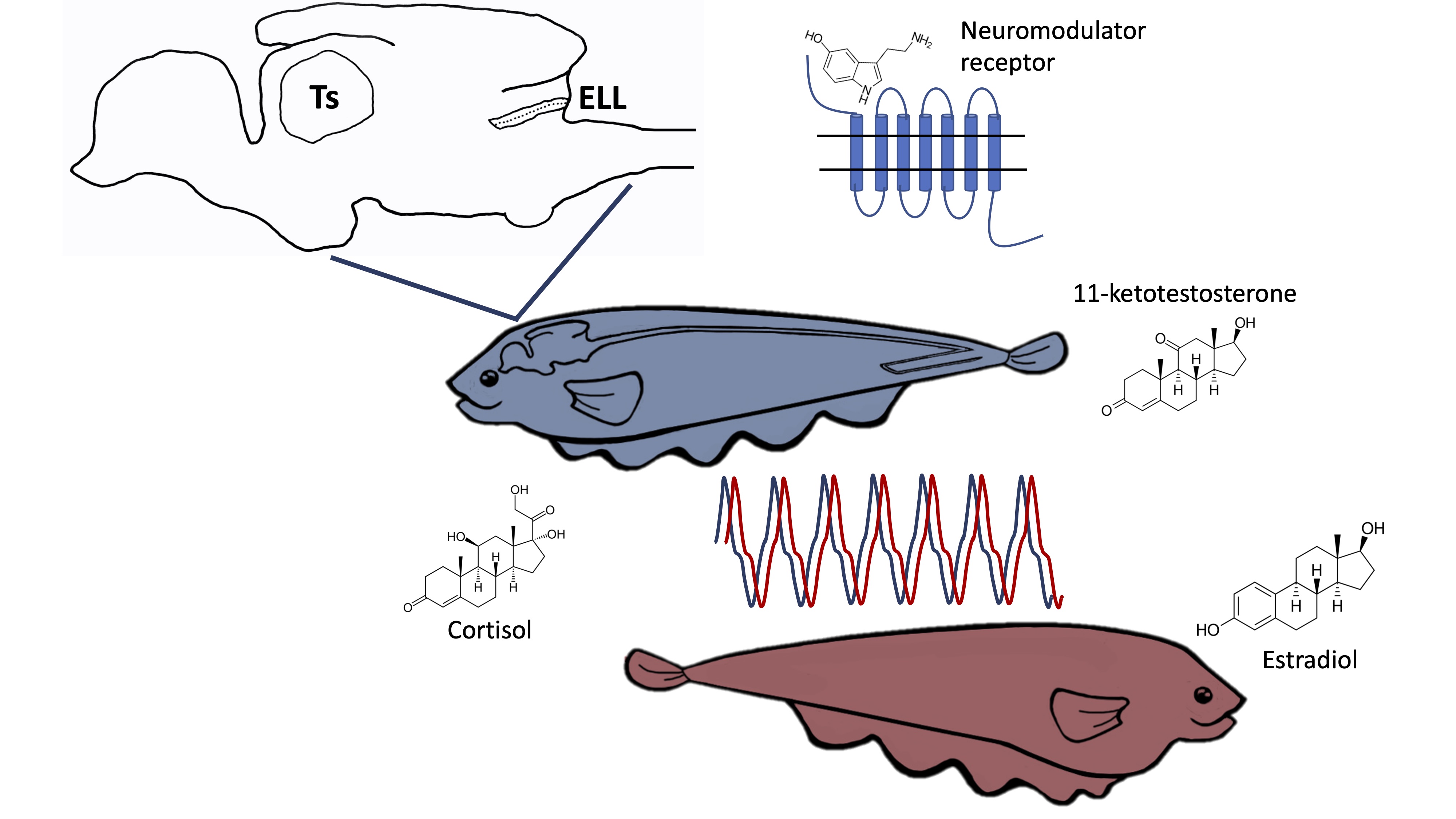Neuroendocrine modulation of signal function and perception across social environments
Electric fish exhibit differences in social behavior across species. Some species, like black ghost knifefish (Apteronotus albifrons), are highly territorial and aggressive. Other species are more gregarious and social, like Adontosternarchus spp. (McNeil et al. 2014). Brown ghost knifefish (Apteronotus leptorhynchus) have dominance hierarchies but are less aggressive than black ghost knifefish. Within species, fish also communicate in a number of different social contexts that can vary with sex, reproductive state, status, and social experience. We are investigating how differences in sociality and social context underlies the variation in how electrocommunication signals are used and perceived during social interactions. Hormones and neuromodulators often control sex and species differences in electrocommunication signals. These modulators are also likely to influence how fish use and process signals in different social environments. By examining how steroid hormones and neuromodulator receptor gene expression in electrosensory brain regions changes in response to social experience we aim to identify the mechanisms underlying the evolution of chirp diversity (click here for background information on chirping).
We use three different techniques to ask how social environment and neuroendocrine processes regulate chirping.
(1) Compare chirp function in different social contexts during social housing
Social complexity often necessitates signal complexity in gregarious communication systems, where remembering individual identity and social partners might be particularly important (Matrosova et al. 2011, Pollard and Blumstein 2012). We are trying to identify how chirp dynamics vary across species with different levels of sociality. Fish are paired together in their home tanks with same-sex or opposite-sex conspecifics and recorded overnight to collect data on chirping. We then analyze the temporal dynamics of chirping across the night and compare differences in chirp types and rate across context and species with varying levels of sociality. Social species may have more types of chirps for different functions compared to territorial species (click here to learn more about our research on the functions of EODs and chirping).
Recording from social housing experiment
Recording from two male black ghost knifefish housed together in a tank across a divider. Fish were allowed to interact electrically, but not physically. Both fish are chirping. |
(2) Identify how social experience modulates steroid hormone production
Gonadal steroid hormones control differences in the degree of sexual dimorphism in electrocommunication across species (Smith et al. 2013) (click here to learn more about our research on the hormonal mechanisms underlying species and sex differences). Adrenal steroids can also influence chirping. Similar to social interaction, cortisol treatment increases neurogenesis and chirp rate (Dunlap et al. 2002, Dunlap et al. 2006). Our lab is interested in how a social experience, both after short-term or long-term social housing, modulates the production of steroid hormones. We collect blood samples before, during, and/or after short or long-term social interactions to measure levels of cortisol, 11-ketotestosterone, testosterone, and estradiol. By comparing the change in steroid levels across different social environments and species, we can identify the hormonal mechanisms that regulate the response to social experience.
(3) Quantify neuromodulator receptor gene expression in sensory brain regions following social interaction
Neuromodulatory systems in sensory brain areas encode social context and they often vary across species with different social structures (Goodson et al. 1999). After a social experience, we measure the amount of mRNA for neuromodulator receptors in sensory brain regions using qPCR. The electrosensory lateral line lobe (ELL) receives input from electroreceptors and encodes chirp parameters in the brain. The ELL then projects to the Torus semicircularis (Ts) (the teleost homolog of the inferior colliculus), a midbrain structure involved in the higher-order neural processing of communication signals (Vonderschen and Chacron 2011, Marsat et al. 2012). Genes of interest include receptors for biogenic amines (dopamine, serotonin) and neuropeptides (vasotocin, isotocin, Substance P), which modulate chirping in sex-specific ways across species (click here to learn more about our research on the neural mechanisms underlying species and sex differences).
 |
Neuromodulation of sensory perception during social interaction. When two fish are in close contact, they both produce EODs that interact to form a beat that the reciever (blue) detects using electroreceptors on its skin. The ELL then encodes amplitude and phase information from the beat. The Ts recieves input from the ELL and is responsible for higher order processing of electrocommunication signals. Circulating steroid hormones (cortisol, 11-ketotestosterone, estradiol) regulate the production of chirps and are responsive to social context. Within electrosensory circuits (ELL, Ts) neuromodulator receptor gene expression is a potential mechanism for regulating species and sex differences in the perception of social communication. |
